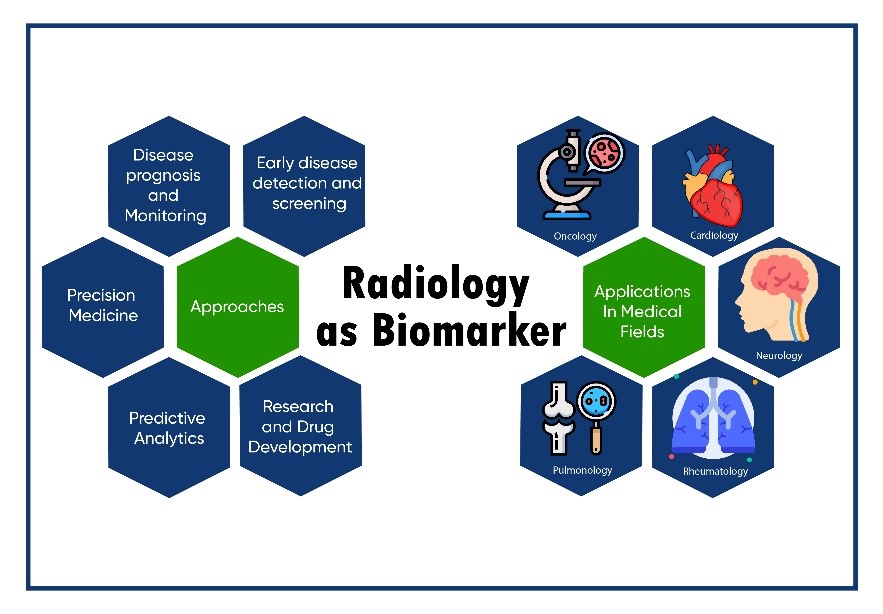
In the dynamic panorama of medicine and healthcare, radiology has always been a frontline driver and contributor. It has primarily been associated with imaging such as X-rays, CT, MRI and ultrasounds to visualize anatomical attributes and identify anomalies. However, recent technological advancements have expanded radiology’s capabilities beyond this. It is now poised to become a potent biomarker in the medical industry. In this blog, we will explore the exciting prospects and implications of using radiology as a biomarker which would open a new vista in the wider field of patient care and medicine.
Prelusively, a biomarker is a quantifiable physiological or metabolic trait that can reveal details about a condition or disease. The NIH project on biomarkers and surrogate endpoints has categorised imaging biomarkers as scientifically validated metrics or indicators of pathological processes, normal biological events, or pharmacological reactions to a therapeutic intervention. Biomarkers must be measurable, but can be numerical (quantitative) or categorical (qualitative data). As compared to other conventional biomarkers such as molecular, histologic or physiologic ones which are based on blood tests or genetic markers, radiological biomarkers provide a distinct advantage of exhibiting a dynamic and real-time view of the body’s internal structures and processes that is detectable on an image. Radiomics identifies small patterns, textures, and shapes that are imperceptible to the human eye by breaking images down into a plethora of data points. These data-driven findings have the potential to identify biomarkers that can serve as early warning signs of illness and enable rapid treatment. The realistic advancement of health diagnostics and medications hinges on imaging or radiology biomarkers.

Radiology biomarkers, also called as imaging biomarkers would be mainstay biomarkers in the future. These can detect diseases at an earlier stage, enabling for earlier intervention and therapy. Furthermore, these also provide valuable insight of disease progression and prognostication and treatment response, delivering useful inputs to clinicians. Additionally, radiomics data can create personalized treatment plans, optimizing medication tailored to specific patients. Moreover, AI-powered prediction models can foretell disease outcomes, allowing doctors to make proactive patient care selections. Radiological biomarkers can be employed in clinical trials to evaluate the efficacy of novel medications and therapies, hence speeding up drug development. A number of imaging biomarker alliances, including the European Imaging Biomarkers Alliance (EIBALL) and the Radiological Society of North America (RSNA) Quantitative Imaging Biomarkers Alliance (QIBA®), are establishing standards for biomarker development, validation, and implementation. Imaging biomarkers are growing increasingly crucial in different medical fields such as cardiovascular disorders, cancer, neurologic and psychiatric disease, musculoskeletal disease, metabolic disorders, and inflammatory and autoimmunity-based disorders. In clinical practice, a variety of imaging biomarkers are being used. For example, Quantitative imaging biomarkers that describe tissue properties include calcium, fat, and iron accumulation, cellularity, perfusion, hypoxia, diffusion, necrosis, metabolism, lung airspace density, and fibrosis and assist in determining the diseased state. CT (or MRI) measures of tumor volume changes in cancer treatment are centered on the “Response Evaluation Criteria in Solid Tumors” (RECIST) criteria.
Nevertheless, the prospect of radiology as a biomarker is enormous, there are several challenges that need to be addressed. Data security and privacy and the requisite for meticulous validation of AI algorithms, ethical considerations with the use of AI in radiology are critical issues. Furthermore, standardization of protocols and guidelines are paramount to assure constancy in radiomics research and clinical applications. Ethical principles and technological improvements must be harmonized for the responsible integration of radiology as a biomarker.
The future of radiology as a biomarker is an invigorating edge in medicine. The world of radiology biomarkers and their integration with radiomics and AI, would bring a paradigm shift in medical diagnosis, improvement in patient care and more personalized treatment and progress in medical research.





0 Comments